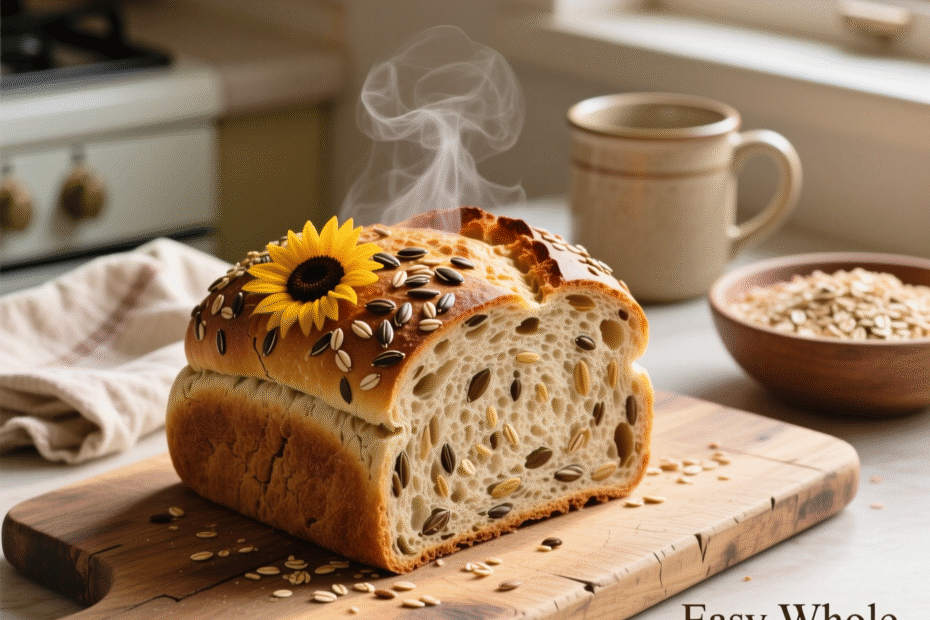There’s something deeply comforting about the smell of freshly baked bread wafting through your kitchen—especially when you know it’s made with wholesome, nourishing ingredients. In a world full of ultra-processed snacks and quick-fix meals, returning to the basics like homemade whole grain bread isn’t just nostalgic; it’s a powerful step toward better health and mindful eating. And the best part? You don’t need to be a master baker or spend hours in the kitchen to enjoy it.
In this article, we’ll explore how to make easy whole grain bread that fits seamlessly into your everyday meals—whether you’re toasting it for breakfast, packing sandwiches for lunch, or serving it alongside a cozy dinner. We’ll break down why whole grains matter, share a simple and reliable recipe, offer practical tips for beginners, and even suggest creative ways to use your loaf beyond the usual slice-and-spread. By the end, you’ll see that baking your own bread isn’t just doable—it’s deeply rewarding.
Let’s knead our way into a healthier, tastier routine, one loaf at a time.
Why Whole Grain Bread Belongs in Your Daily Diet
Whole grain bread isn’t just a “healthier alternative”—it’s a nutritional powerhouse that fuels your body with fiber, vitamins, and slow-releasing energy. Unlike refined white bread, which strips away the bran and germ (the most nutrient-dense parts of the grain), whole grain bread retains all three components: bran, germ, and endosperm. This means more fiber, B vitamins, iron, magnesium, and antioxidants in every bite.
According to the Dietary Guidelines for Americans, adults should aim for at least half of their grain intake to come from whole grains. Yet, many people fall short—often because store-bought “whole wheat” loaves are loaded with added sugars, preservatives, or misleading labels. Making your own ensures you control exactly what goes into your bread: no hidden ingredients, no compromises.
Beyond nutrition, whole grains support long-term health. Studies consistently link regular whole grain consumption to a lower risk of heart disease, type 2 diabetes, and even certain cancers. Plus, the fiber helps keep you full longer, stabilizes blood sugar, and supports a healthy gut microbiome.
And let’s not forget flavor: whole grain bread has a rich, nutty depth that refined flour simply can’t match. Once you taste a truly fresh, homemade slice, you may never go back to the supermarket version.
A Foolproof Recipe for Effortless Whole Grain Bread
You don’t need a stand mixer, a sourdough starter, or hours of waiting to bake delicious whole grain bread. In fact, this easy recipe requires just one bowl, basic pantry staples, and about 10 minutes of hands-on time.
Ingredients:
- 1½ cups warm water (about 110°F / 43°C)
- 2¼ teaspoons active dry yeast (1 standard packet)
- 2 tablespoons honey or maple syrup
- 2 tablespoons olive oil or melted butter
- 1½ teaspoons salt
- 1½ cups whole wheat flour
- 1½ cups bread flour (or all-purpose flour)
- Optional: 2–3 tablespoons seeds (sunflower, flax, sesame, or oats)
Instructions:
- In a large bowl, combine warm water, yeast, and honey. Let sit for 5–10 minutes until foamy—this confirms your yeast is active.
- Stir in oil and salt.
- Add whole wheat flour and mix until combined. Then add bread flour gradually until a soft dough forms. It should be slightly sticky but manageable.
- Knead by hand for 5–7 minutes on a lightly floured surface (or use a mixer with a dough hook for 3–4 minutes) until smooth and elastic.
- Place dough in a greased bowl, cover with a damp towel, and let rise in a warm spot for 1–1.5 hours, or until doubled in size.
- Punch down the dough, shape it into a loaf, and place it in a greased 9×5-inch loaf pan.
- Let it rise again for 30–45 minutes.
- Preheat oven to 375°F (190°C). Bake for 30–35 minutes, until golden brown and the internal temperature reaches 190°F (88°C).
- Cool completely on a wire rack before slicing.
Why this works: The blend of whole wheat and bread flour gives you the nutritional benefits of whole grains while ensuring a light, tender crumb. The small amount of sweetener feeds the yeast without making the bread taste sweet—just balanced and aromatic.
Baking Tips for Beginners (and Busy People)
If you’ve ever been intimidated by bread baking, you’re not alone. But with a few simple strategies, even the busiest home cooks can turn out a beautiful loaf.
First, embrace flexibility. Your kitchen doesn’t need to be bakery-perfect. Yeast is forgiving—slightly cooler water? It’ll just rise slower. Forgot to preheat? No problem. Bread baking is as much about intuition as it is about precision.
Second, use what you have. Don’t have bread flour? All-purpose works fine (though the loaf may be slightly denser). Out of honey? Try brown sugar or even mashed banana for natural sweetness and moisture. Seeds and grains can be swapped based on what’s in your pantry—chia, millet, or cracked wheat all add texture and nutrition.
Third, plan ahead—but not too far ahead. You can mix the dough the night before and let it rise slowly in the fridge overnight. In the morning, shape it, let it rise at room temperature for an hour, and bake. This “retard” method actually enhances flavor and makes the process fit into even the busiest schedules.
And remember: Your first loaf might not be Instagram-perfect—and that’s okay. What matters is that it’s real, nourishing, and made with your own hands. Each bake teaches you something new: how your kitchen’s humidity affects rise time, how your oven runs hot or cool, or how your family prefers their crust (soft or crunchy?).
Beyond the Loaf: Creative Ways to Use Whole Grain Bread
Once you’ve mastered your basic loaf, the fun really begins. Whole grain bread is incredibly versatile—far beyond peanut butter and jelly.
Think breakfast: Turn slightly stale slices into whole grain French toast by soaking them in a mixture of eggs, milk, cinnamon, and a splash of vanilla. Top with fresh berries and a drizzle of pure maple syrup for a fiber-rich morning meal.
For lunch: Upgrade your sandwich game. Layer roasted vegetables, hummus, and arugula on toasted whole grain bread for a satisfying, plant-powered bite. Or make a classic BLT with avocado— the hearty texture of whole grain bread holds up beautifully to juicy tomatoes and crispy bacon.
Dinner sides? Absolutely. Tear your bread into chunks, toss with olive oil, garlic, and herbs, and bake into homemade croutons for soups and salads. Or blend dried crusts into breadcrumbs for coating chicken cutlets or topping casseroles.
Even dessert gets a boost: Try bread pudding made with whole grain bread, almond milk, cinnamon, and chopped apples. It’s comfort food with a nutritional twist.
And don’t toss those end pieces! Dry them out and grind them into homemade breadcrumbs—freezer-friendly and perfect for meatballs, veggie burgers, or breading fish.
By using your loaf creatively, you reduce food waste, save money, and keep meals exciting—all while sticking to wholesome ingredients.
The Joy of Slow Food in a Fast-Paced World
In a culture obsessed with speed—fast food, instant meals, one-minute recipes—baking bread is a quiet act of rebellion. It asks you to slow down, pay attention, and reconnect with the rhythm of making something real.
Kneading dough becomes meditation. Watching it rise teaches patience. The aroma that fills your home? That’s not just yeast and flour—it’s care, intention, and presence.
There’s also a deep sense of accomplishment. In under two hours, you transform a handful of simple ingredients into something nourishing and beautiful. That’s powerful in a world where so much feels out of our control.
And when you share that loaf—with your kids, your partner, or a neighbor—you’re sharing more than food. You’re sharing time, effort, and love. That’s the magic of homemade bread: it feeds both body and soul.
So even if you only bake once a month, or once a season, give yourself permission to try. You’re not just making bread—you’re reclaiming a piece of everyday joy.
Conclusion
Making easy whole grain bread for everyday meals isn’t just about eating healthier—it’s about embracing a simpler, more intentional way of living. We’ve explored why whole grains matter, shared a beginner-friendly recipe that delivers great results, offered practical tips for fitting bread baking into a busy life, and shown how one loaf can inspire countless delicious meals. Most importantly, we’ve reminded ourselves that good food doesn’t have to be complicated to be meaningful.
You don’t need perfection. You just need flour, water, yeast, and a little curiosity. Every loaf you bake is a step toward better health, more mindful eating, and deeper connection—with your food and with yourself.
So why not give it a try this weekend? Clear a little space on your counter, gather your ingredients, and see what you can create. Your kitchen—and your body—will thank you.
We’d love to hear from you! Have you baked whole grain bread before? What’s your favorite way to enjoy it? Share your tips, questions, or photos in the comments below—let’s build a community of home bakers, one slice at a time.

Thayná Alves is an influential digital content creator who has carved out a significant space in the realms of technology, finance, and entrepreneurship. Through her blog, Newbacker.com , she stands out as an authentic and accessible voice for individuals seeking practical information about investments, innovation, and emerging trends in the financial market.
